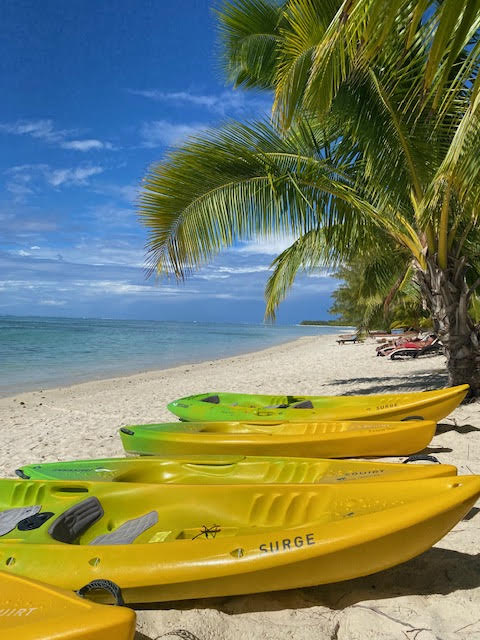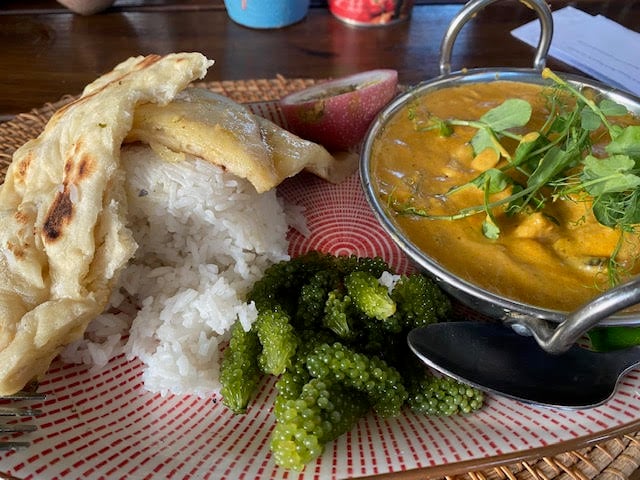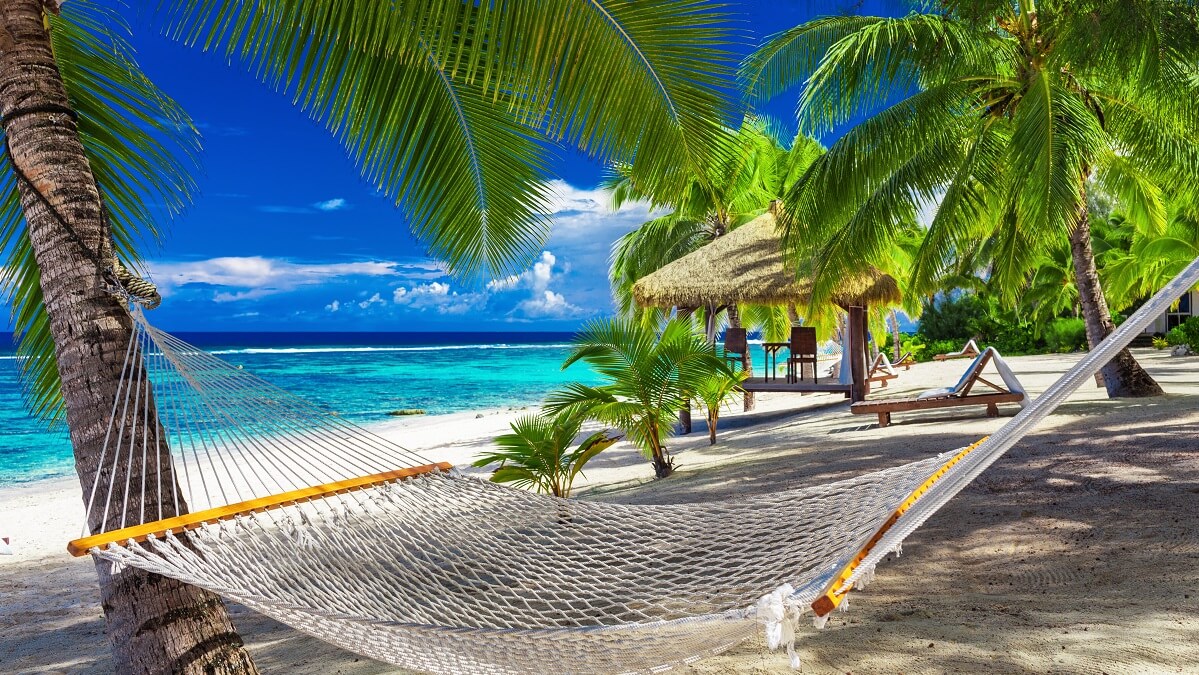Describing a holiday destination as paradise is such a cliché, but Aitutaki in the Cook Islands is just that. It is an iconically beautiful tropical island and has what many assert is the most beautiful lagoon in the world – and the best beach.
It is also unspoilt, unhurried and wonderfully underdeveloped. Tourists seem to disappear into the swathes of coconut trees. Crowds are non-existent. There is not a traffic light on the island.
Also non-existent are predators. Australians are mindful of snakes, stonefish, box jellyfish, crocs and wild dogs. But the worst you come across here are centipedes. You’d have to be unlucky.
Aitutaki is the second most visited island – after Rarotonga – in the Cook Islands. If you think Rarotonga is brilliant, you’ll be as hard pressed as I am to find words to describe Aitutaki.
Aitutaki is just 17 square kilometres in size (with a high point barely 100 metres above sea level), but its lagoon is so huge (74 square kilometres) that Rarotonga could fit inside. It’s shaped like an equilateral triangle, with each side about 12 kilometres, and there are 14 tiny islands – or motu – in it. All but one are uninhabited.
I’m told, Aitutaki is a favourite destination with honeymooners, but this couple 40 years married is just as bewitched.

Getting there
Day trips from Rarotonga are available but, if you can, spoil yourself with a longer visit – as long as time and budget permit.
As you fly in on the 40-minute Air Rarotonga flight, it’s impossible to tear your eyes from the crystal clear turquoise of the massive lagoon. It’s a ‘pinch-me’ moment.
There’s a complementary pick-up service from our accommodation, Tanamu Beach Resort, and my husband and I receive the traditional exquisitely made gardenia ei katu (garland). Is there a better perfume?
The resort is less than five kilometres from the airport and on arrival we’re given a comprehensive briefing and invited to have a complementary 10-minute foot massage.
Island identity and Uber owner Auntie K arrives to give us a tour of the island and share stories of land title disputes, the crowning of the most recent ariki (chief), centuries-old massacres and the history of the seven churches on the island. She has also packed a lunch that showcases the island’s natural produce – pawpaw, mango, bananas, oranges, salad.
Tourism dominates the economy, but as with Rarotonga – there are no touts, no-one pressuring you to buy, no language worries, the crime rate is almost non-existent, the buildings all sit low among the natural vegetation and traffic lights are a distant memory.
The permanent population is less than 2000, yet there are three primary schools and one secondary college. One can only assume class sizes are very small. Plus, there’s a general hospital.

Where to stay and eat
There’s a variety of accommodation on Aitutaki – although as with Rarotonga there’s no camping – but there are options to suit all budgets.
Tanamu Beach Resort is a series of luxurious individual coconut-frond thatched villas that spear back from the beach – one section is adults only and one for families. Both have pools, but with the lagoon just metres away, they’re almost superfluous to requirements.
The accommodation is delightful: a glorious private outdoor shower as well as a spacious indoor bathroom, basic kitchen with coffee pod machine. The king-sized bedroom has both fan and air-conditioning. There’s a TV but I couldn’t tear my eyes from the view.
The resort has a large open dining area for meals – with barista coffee. If you’re in the adults area, it’s a short stroll along the beach,.
On our second (and sadly last night) we were lucky enough to enjoy a buffet dinner and weekly show at Tanamu. The island’s culture, dance and music were vividly on display.
We also ate at quirky café Avatea, further inland, enjoying a delicious fish curry with naan and a salty sea plant we’d never heard of. The café shop is also worth a visit. But take insect repellent as dining is under cover but outdoors. And do book.
On the point past the airport is O’otu Beach, where we collected our rental car, and a cluster of small restaurants.
What to do
Perhaps nothing should be your first option, as in nothing but enjoy where you are on the planet’s most prized lagoon.
But … you could consider a lagoon cruise, a visit to One-Foot Island, which is regularly described as the world’s best beach, perhaps a fishing charter. My husband headed off for a four-hour charter ($350 – he was the only one) and caught a wahoo and a tuna. They were dinner somewhere.
There are kayaks, stand-up paddle boards, bicycles and snorkelling gear freely available at our accommodation. Take your own snorkel if you prefer because snorkelling is a must.
The lagoon is bathwater warm (the temperature rarely drops below 22ºC) and ridiculously clear, the myriad fish in water that is less than a metre deep are of every conceivable colour, the distant sound of the breakers over the reef just a hum. Hundreds of sea cucumbers festoon the lagoon bed and out near a marker are exquisitely patterned clams.
The visual feast drives home the mantra ‘be in the moment’. How could you not? Work and life’s usual worries are a million miles away.

Getting around
We hired a car so we could see as much of the island as possible over two days, but scooters and bicycles are very practical. The maximum speed is 50kmh and it drops to 20kmh and 30kmh in some areas.
What else to know
Prices for food and wine are similar to Australia and you can drink the water without a worry. Some things, however, are more expensive – such as petrol and insect repellent.
Maximum temperatures in summer reach the high 20s and in winter temperatures are in the mid to low 20s. Minimums rarely dip below 20. Humidity is high in summer.
Best time to visit is April through to November – the dry season.
Take some Cook Islands currency, although your usual credit and debit cards work fine.
Beware the time difference when booking. It could be easy to misunderstand the 21-hour difference (AEDST) and end up with a night’s accommodation you didn’t – or did – need.
Aitutaki – and the Cook Islands – were never on my bucket list. They should be on yours.
Note: Jetstar flies direct between Sydney and Rarotonga.
Janelle Ward visited Aitutaki as a guest of Cook Islands Tourism.
What’s your favourite Pacific island? Do you prefer getting away from the madding crowd or getting amongst the crowds? Why not share your thoughts in the comments section below?
Also read: Jetstar announces direct flights to the Cook Islands

